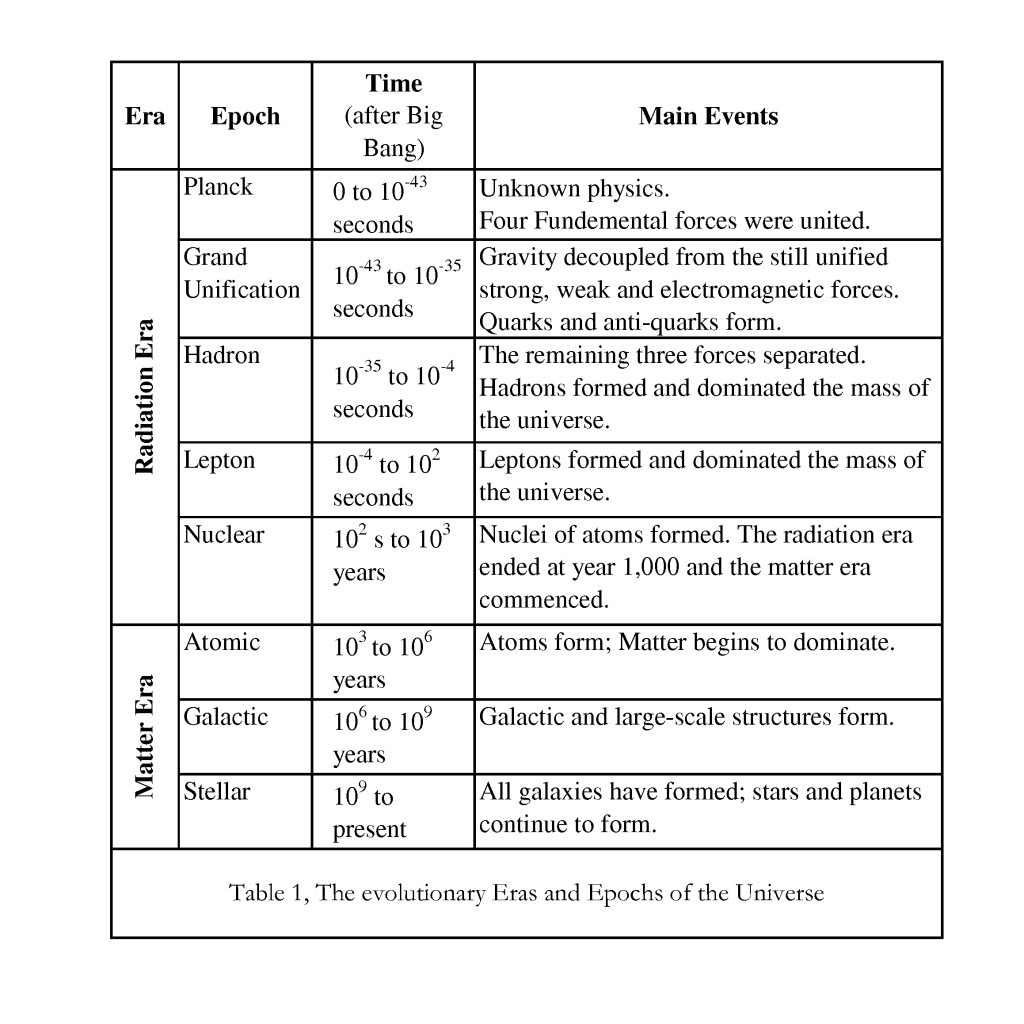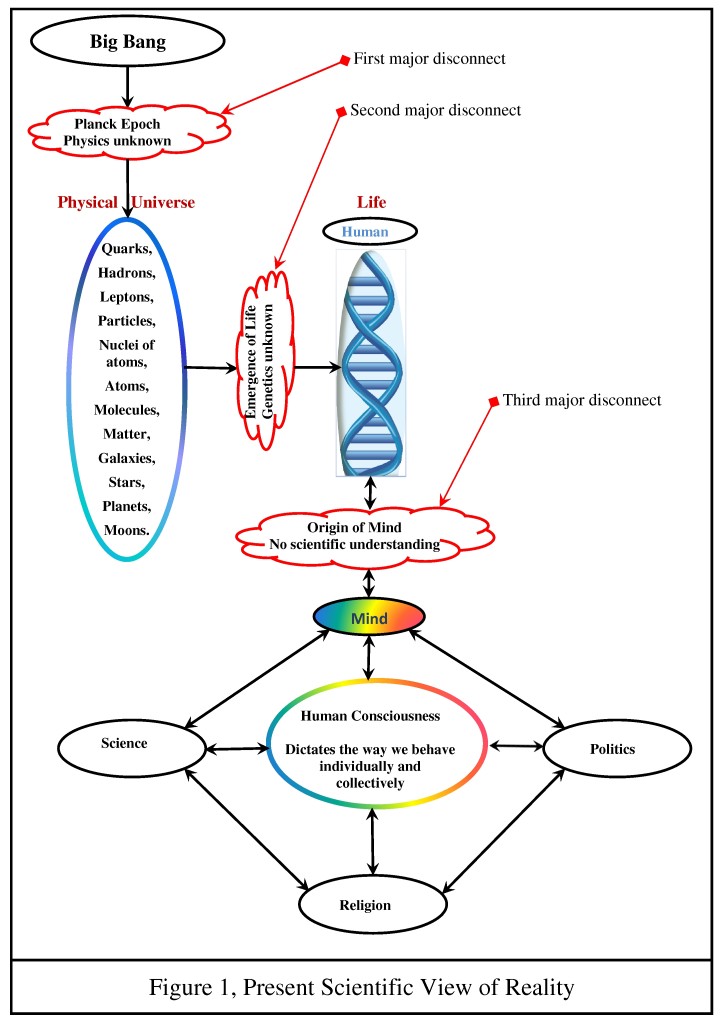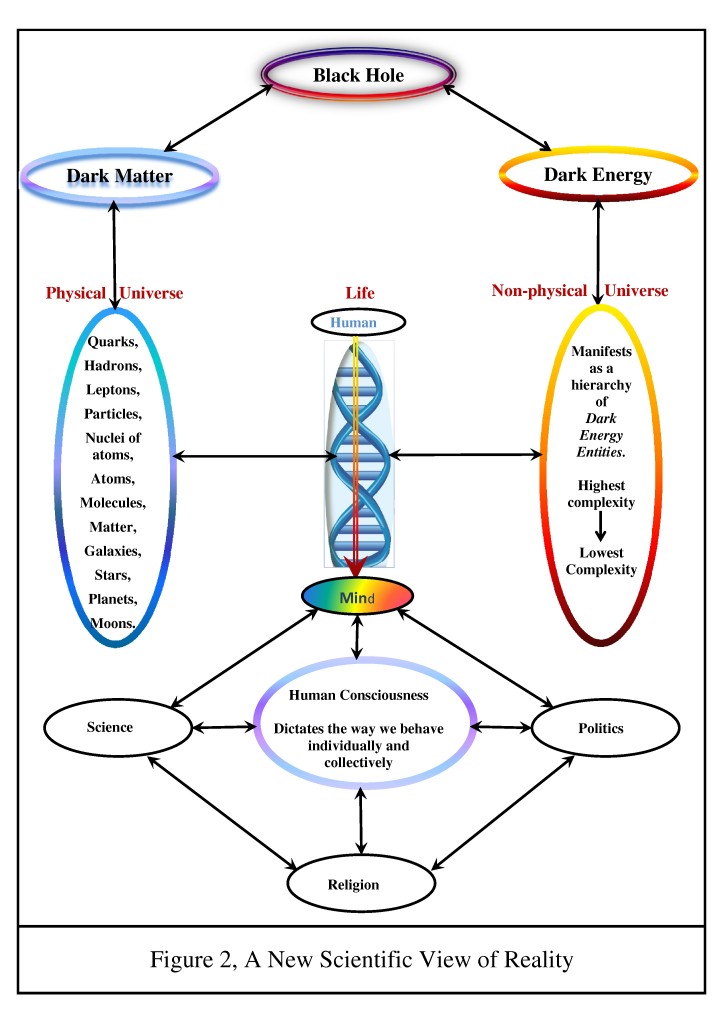In 1931, Monseigneur Georges Lemaître proposed in his hypothèse de l’atome primitif (hypothesis of the primeval atom) that the universe began with the ‘explosion’ of the ‘primeval atom’. This theory later became known as the Big Bang Theory.
In my blog dated 9th Nov 2014 I gave logical reasons why the Big Bang theory is not a credible model for explaining the origin of the universe. In this blog I will explain an alternative model, which I have named the Grand Interactive Model. This model not only logically explains the origin and evolution of the universe, but is also consistent with the concept of the inflationary period and the observation that CMB is uniform in all directions.
The Source
Logic suggests that the source of all should be consistent with the concept of ‘Unity’. The black hole information paradox suggests that physical information could disappear in a black hole, allowing many physical states to evolve into exactly the same state. This suggests that complete unity exists inside a black hole. In other words, everything that is drawn into a black hole is transformed by its enormous internal forces into a ‘homogeneous essence’ or complete ‘unity’. Should this be the case, there is a strong logical argument to suggest that the black hole state is the source of all.
Planck Epoch
The evolution of the universe is frequently described in two eras and eight epochs, see Table 1.
The physics of the Planck epoch is unknown. At the present time scientists posit that dark energy and dark matter make up 96% of the whole – even though they have no knowledge regarding their nature. However it is logical that these two phenomena preceded the existence of ordinary matter, since they form the major proportion of the whole.
The Grand Interactive Model posits that dark matter and dark energy emerged from the black hole state in the Planck epoch. They then proceeded, with velocities much greater that the speed of light, to create all of space – since matter did not yet exist at that time, dark matter and dark energy could have expanded at ‘velocities approaching infinity’.
The Physical Universe1
In the Grand Unification epoch quarks formed from dark matter and gravity emerged as a fundamental force. The physical universe then evolved in accordance with scientific theory, with the formation of hadrons, leptons, nuclei of atoms, atoms, molecules, matter, galaxies, stars, planets, and moons – all the way up to the universe as we know it today.
The Non-Physical Universe2
Physical entities, from quarks to planets, all emerged from dark matter; so it is logical to assume that dark energy entities emerged from dark energy and formed a non-physical universe in an analogous way. These non-physical entities are not observable or detectable by the science of the physical universe.
Life
When conditions allowed, matter and non-physical entities united to form life. Life, mind, and human consciousness are therefore influenced by both the physical and non-physical aspects of life. The natural propensity of the physical aspect is towards lower complexity, as explained by the second law of thermodynamics and the concept of entropy; and the natural propensity of the non-physical is toward higher complexity. They are therefore the two forces keeping ‘tension’ on life, thus keeping it in existence, see my blog dated 12th Nov 2014.
Comparison of the two models
Figures 1 and 2 below represent the present and new views of reality which result from the Big Bang model and the Grand Interactive Model respectively.
There is a fundamental logic to Figure 2 for the following reasons:
- The lines connecting each aspect have arrow heads in both directions representing the reality that every aspect influences, and is influenced by, every other aspect
- There is a continuous connection between the source of the universe and human consciousness
- There is a continuous cycle of emanation, manifestation and return throughout the life of the ‘whole system’
- The source continues to interact with the ‘whole system’ continuously throughout its life, see my blog dated 9th Nov 2014.
By contrast, Figure 1 is illogical for the following reasons:
- As shown, there are three major disconnects and many one-way arrows
- The source seems to be completely ‘used up’ in the act of creating the system and consequently there is no continuous interaction between the source and the system, see my blog dated 9th Nov 2014.
- There is no continuous cycle of emanation, manifestation and return throughout the life of the ‘whole system’.
Inflationary Period
According to Alan Guth, a scientist at the Massachusetts Institute of Technology, the radius of the universe increased by 1030 times in only a fraction of a second, sometime around the Grand Unification epoch. The Grand Interactive Model suggests that dark matter and dark energy emerged in the Planck epoch. In these states velocities could have approached infinity since matter did not yet exist. Even in the Grand Unification epoch, when quarks emerged, velocities could have exceed the speed of light since matter had not yet started to ‘clump together’ – which only started in the Hadron epoch. Therefore the inflationary period could logically have occurred during the Planck and Grand Unification epochs and possibly the early Hadron epoch.
Cosmic Microwave Background (CMB)
The observation that CMB is uniform in all directions is one of the arguments supporting the Big Bang theory. However the Grand Interactive Model can logically explain this observation as follows:
- By the time quarks emerged, dark matter would have already expanded to fill ‘all of space’. Therefore quarks would have emerged uniformly throughout space
- During the Grand Unification epoch and the early part of the Hadron epoch, because matter had not yet started to ‘clump together’, particle velocities, and therefore temperatures, would have been extremely high throughout all of space, which explains the uniformity of CMB.
In blogs over the coming months I will explain how the Grand Interactive Model provides logical explanations for many concepts in physics that are either counter-intuitive or not fully understood; for example quantum gravity, particle entanglement, wave particle duality, and many other concepts in quantum physics.
Foot Notes
- Physical (or physical universe) can be defined as all forms of matter, energy, and momentum, and the physical forces, laws, and constants that govern them.
- Non-physical (or non-physical universe) can be defined as everything other than the physical. The non-physical can be viewed as pre-physical or pre-particle – in other words, the state that existed (and still exists) before elementary particles emerged. I believe that both dark matter and dark energy are non-physical which means the physical state only accounts for 4% of reality.
Recent Posts
- Scientific Support for Brexit July 5, 2018
- The Evolution of Human Consciousness November 12, 2015
- Will Science Retreat into a Cul de Sac – just as Theology did before them? September 22, 2015
- Corruption and Abuse of Power are the Source of all the Major Problems in our World September 9, 2015
- A United Europe. Is it a crazy idea? – or – Is it a necessary step in the evolutionary journey of the human race? August 11, 2015
- A New Scientific View of Reality based on The Grand Interactive Model June 9, 2015
- Humanity can create a world dominated by Love, Care, and Compassion April 13, 2015
- The Origin and Evolution of the Universe – The Grand Interactive Model November 28, 2014
- The roles science and theology have played in creating our present world of pain and suffering November 25, 2014
- Science and Theology – A Common Understanding November 18, 2014
Archives
- July 2018 (1)
- November 2015 (1)
- September 2015 (2)
- August 2015 (1)
- June 2015 (1)
- April 2015 (1)
- November 2014 (6)
- October 2014 (6)
- July 2014 (1)






Recent Comments